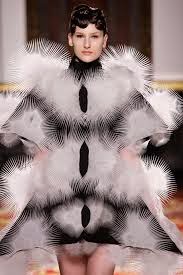My
last three rotations have been weave, embroidery and then I returned for mixed
media for the last 3 weeks of sampling. I believe context really helps to put
in perspective what it is you’re actually making and where you can imagine your
work being shown. However, I found this hard to visualise when it came to
embroidery. I think this might have something to do with how much I really was
not enjoying this rotation and I found myself just viewing the samples as a way
of completing the amount that needed to be done in the time period given. Context
with mixed media has always been clear for me since I discovered the work of
Iris Van Harper. I was inspired by her approach to sculptural fashion. However,
the more the mixed media rotation has progressed, I find myself envisioning my
work actually to be just a sculpture piece in itself.
Reflecting
on these 3 rotations, I think the context was most clear when in weave. The
influence and inspiration for the journey and discovery of future contexts for
my work was very much clear to me. I found that this was because of the artists
Elizabeth Ashdown and Yayoi Kusama, whose work I found interesting.
As
soon as I found Elizabeth Ashdown’s work this influenced the materials I could
use to then see how far I could push the loom.
 |
| Weave Samples by Elizabeth Ashdown |
Using yarns such as pipe cleaners, elastic and taking
yarn straight off the bobbin created big textures. Then I realised I was
pushing it too far and that I needed to strip it down. I knew that I wanted to
take the idea of using different materials which created this 3D sculptural approach,
however still to have that beautiful weave structure. I remembered how much I
loved Yayoi
Kusama’s simplicity in a certain piece of work I was interested in and how much
I loved the plain background with the splash of colour.
 |
Yayoi Kusama's Obliteration Room Pic 1 |
 |
Yayoi Kusama's Obliteration Room Pic 2 |
From
this process, I combined the two approaches to then influence my final outcome,
which is shown below.
I feel this
sample shows clear inspiration from the artists mentioned and from my drawing
work. For example, the data collection research of the lines created from the
length of streets and the colours of my five senses page.
If I was to
take this further or if I had more time I would increase the scale of the
sample, so I could see what it would look like in the context I imagined it to
be. A bigger scale would highlight the sculptural features and provide a
clearer perspective on whether the sample design would work as a sculptural
textiles piece.
By
considering context within my work, this has helped to guide me towards the
artists and work I am inspired by and to then think of how I would want others
to see my work in the future.














